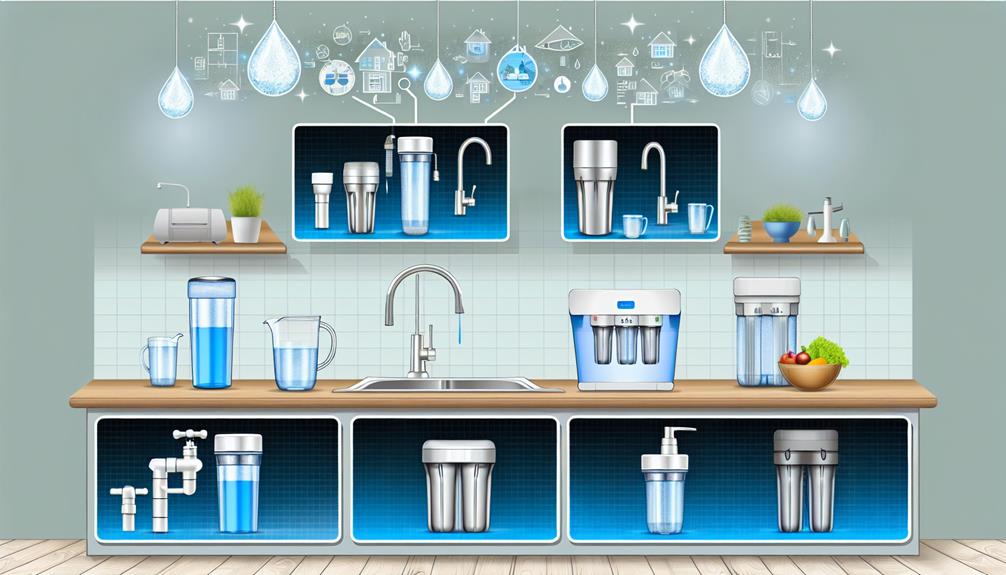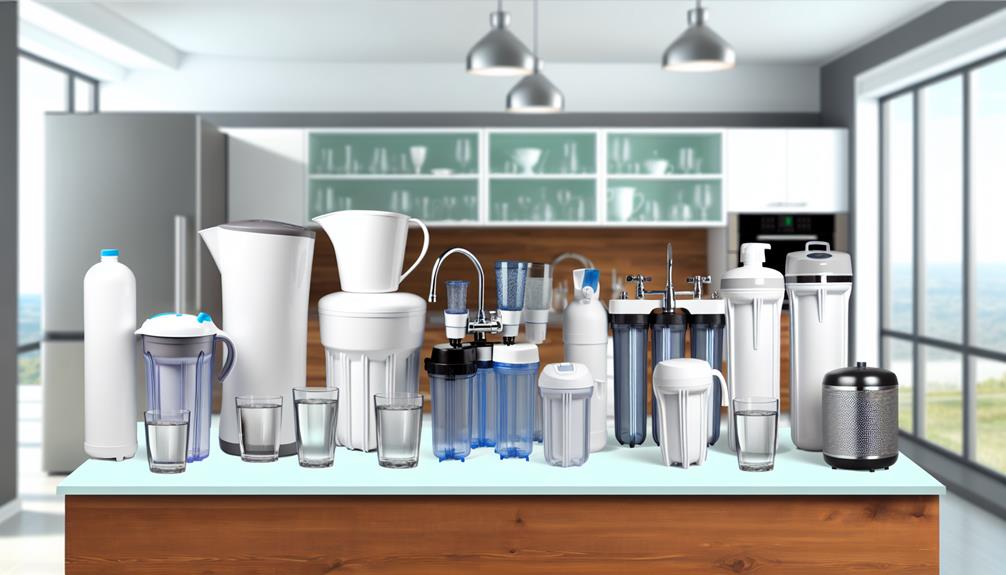Navigating the world of home water filtration systems can be as challenging as finding a clear path through murky waters. You're seeking purity and peace of mind, but the array of choices might leave you feeling adrift in a sea of technical jargon and marketing claims.
As you weigh your options, it's essential to consider factors like the specific contaminants in your water, the size of your household, and the long-term costs involved. You'll need to discern which system not only meets your immediate needs but will also stand the test of time.
Let's dive into the essential tips that will guide you to make an informed decision, ensuring that every sip you take is as safe and refreshing as it should be. Stay tuned to uncover the critical elements that could dramatically transform the quality of your home's water supply.
Assessing Filtration Needs
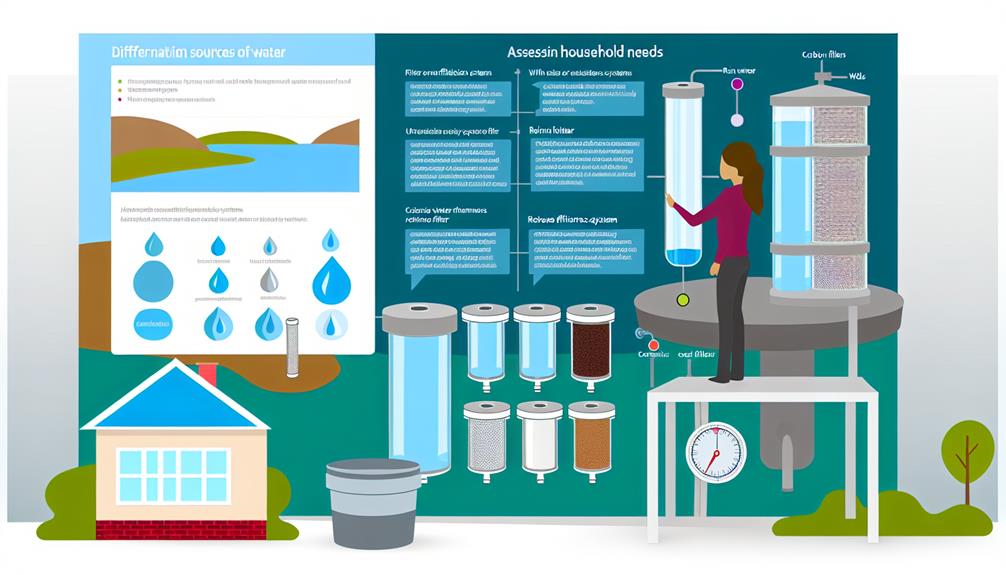
Before investing in a home water filtration system, it's crucial to analyze the specific contaminants present in your water supply to determine the most effective filtration technology for your needs. Water hardness, for instance, is a common issue that can impact both the quality of water and the lifespan of your plumbing. This condition, caused by high concentrations of minerals like calcium and magnesium, necessitates a specialized softening filter to mitigate the adverse effects.
Contaminant testing is an indispensable step in this analytical process. You'll need to collect a water sample and have it tested in a certified laboratory to ascertain the full spectrum of substances you're dealing with. The results will reveal not only the presence of hard water minerals but also any volatile organic compounds (VOCs), heavy metals, chlorination byproducts, bacteria, and other pollutants that could be lurking in your tap water.
Understanding these findings is pivotal, as they guide you to the most appropriate filtration technology. For instance, if your water test indicates high levels of sediment, an initial sediment filter would be advisable, whereas the detection of chemical contaminants might necessitate a more advanced system such as reverse osmosis or activated carbon filtration.
Always opt for a tailored solution that specifically targets the impurities identified in your water to ensure safety and optimal performance.
Understanding Filter Types
You must scrutinize the diverse technologies behind water filtration to select the most suitable system for your home.
Each filter type operates on specific principles and is designed to target particular contaminants and impurities.
Understanding these mechanisms is critical for an informed decision that aligns with your water quality goals.
Filter Technology Explained
When selecting a home water filtration system, it's crucial to understand the various filter technologies available, each employing distinct methods to purify your water.
The core of these systems lies in the filter media, which dictates the efficacy of contaminant interaction and removal.
Activated carbon filters, for example, leverage adsorption, capturing impurities within the pores of the carbon substrate.
Reverse osmosis systems use a semi-permeable membrane, effectively sieving out dissolved solids far smaller than what most other filters can catch.
Ion exchange units exchange contaminant ions for harmless ones, often used for water softening.
Furthermore, mechanical filters block particles based on size exclusion, while UV filters utilize ultraviolet light to inactivate microorganisms.
Each technology offers a different approach, tailored to target specific contaminants within your water supply.
Selecting Your Filter Type
Diving into the realm of home water filtration, it's essential to assess the specific contaminants in your water to determine the most effective filter type for your needs. Understanding the various filtration technologies is crucial as they're designed to target different contaminants.
- Reverse Osmosis (RO): Removes a wide array of contaminants, including dissolved solids, for pristine purity.
- Activated Carbon: Significantly enhances taste improvement by reducing chlorine and other chemicals.
- Ion Exchange: Softens hard water, capturing minerals that cause scaling and residue.
- Ultraviolet (UV) Light: Eradicates bacteria and viruses, offering peace of mind about microbiological safety.
Ensure that the filter you select has the necessary filter certifications, such as those from NSF International, to validate its efficacy and performance against specific contaminants and standards.
Comparing Pitcher and Faucet Systems
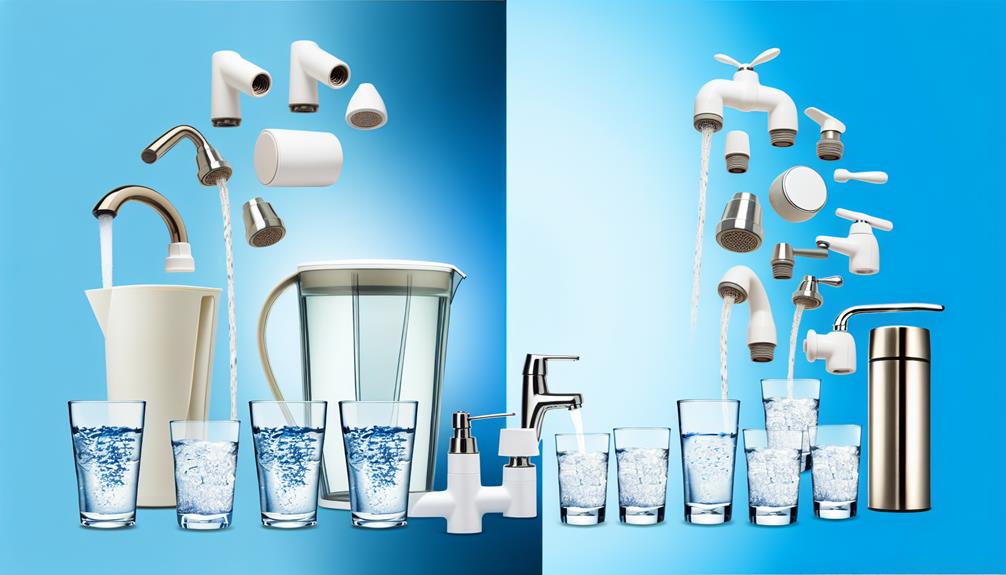
You must weigh the efficiency of filter speed and capacity when choosing between pitcher and faucet water filtration systems.
Consider the initial installation and ongoing maintenance costs that will impact your budget over time.
Analyze these factors to determine which system aligns with your household's water consumption and financial constraints.
Filter Speed and Capacity
While both pitcher and faucet water filtration systems serve the same purpose of purifying your drinking water, they differ significantly in terms of filtration speed and total water capacity. Your filter preferences and usage patterns will guide you in choosing the right system for your household.
- Pitcher Filters: Often slower due to gravity-fed filtration, which can be frustrating during times of high demand.
- Faucet Filters: Provide nearly instant filtration, ensuring a steady flow of purified water.
- Capacity Limitations: Pitchers require frequent refills, not ideal for large families or heavy usage.
- Continuous Supply: Faucet systems generally accommodate higher usage without the constraint of refilling.
Analyzing these factors will enable you to select a filtration system that aligns with your daily water consumption and the pace at which you need it purified.
Installation and Maintenance Costs
Considering your preferred filtration speed and capacity, it's equally important to evaluate the installation and maintenance costs associated with both pitcher and faucet water filtration systems. Analyze the installation timeline and warranty options meticulously to ensure you're making a cost-effective choice.
| Feature | Pitcher System | Faucet System |
|---|---|---|
| Initial Cost | Generally lower | Higher upfront |
| Installation Timeline | No professional help | May require plumbing |
| Maintenance Frequency | Higher | Lower |
| Filter Replacement Cost | Lower per unit | Higher per unit |
| Warranty Options | Limited | Often extensive |
Pitcher systems offer simplicity and lower initial costs, but demand more frequent maintenance. Faucet systems, while pricier upfront, tend to have longer-lasting filters and robust warranty options, potentially saving you money and hassle over time.
Whole-House Filtration Solutions
Whole-house filtration systems offer an efficient solution for ensuring every tap in your home delivers clean, safe water. It's imperative to consider the impact on water pressure when selecting a system. A system with inadequate flow rate can lead to a frustrating reduction in pressure, affecting showers and appliances. Concurrently, the inclusion of a sediment pre-filter is essential to protect the main filter from clogging with debris, thus maintaining optimal performance and prolonging the life of the system.
Consider these critical aspects:
- Water Quality Improvement: A whole-house system targets contaminants like chlorine, sediment, and scale, enhancing the taste, smell, and safety of your water.
- Health Protection: By removing harmful contaminants, you're safeguarding your family's health with every glass of water.
- Appliance Longevity: Clean water minimizes scale buildup, extending the lifespan of your water-using appliances.
- Consistent Water Pressure: A well-designed system ensures that water pressure remains steady, avoiding the annoyance of unpredictable showers and taps.
In your technical assessment, evaluate the system's capacity to handle your household's water consumption without a noticeable drop in water pressure. Ensure that the sediment pre-filter is appropriately rated for your water's particulate level. An analytical approach to these factors will guarantee a robust whole-house filtration system tailored to your needs.
Reverse Osmosis Effectiveness
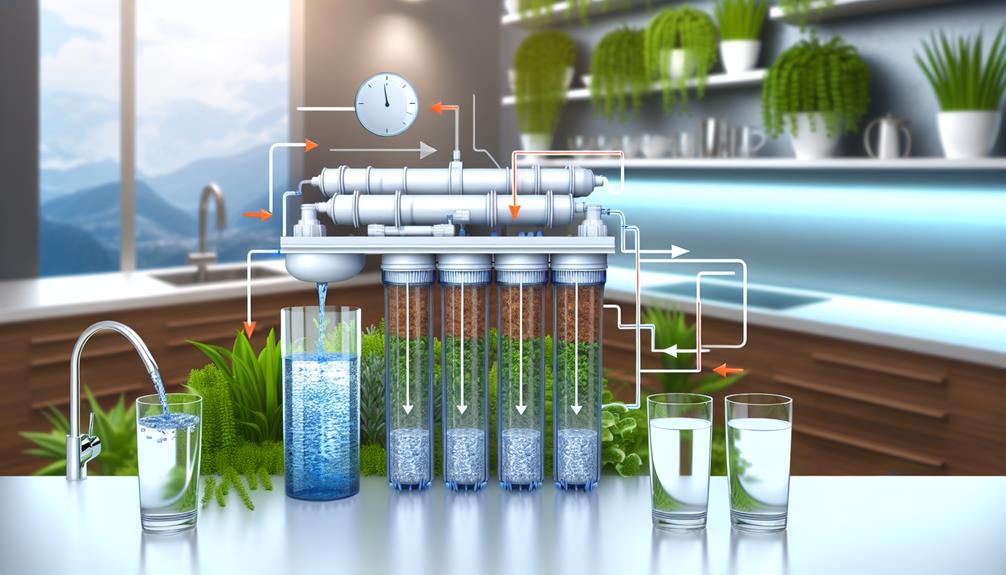
Beyond these whole-home solutions, reverse osmosis systems offer a rigorous level of filtration that can significantly reduce a wide array of contaminants, including those that are molecularly smaller and often challenging to eliminate. As you assess the effectiveness of reverse osmosis, understand that this technology employs a semi-permeable membrane to remove ions, molecules, and larger particles from drinking water.
Analyzing the process in a technical light, the reverse osmosis mechanism forces water under pressure through the membrane, leaving behind contaminants. The system's effectiveness hinges on its ability to tackle pathogens, heavy metals, and even some pesticides, delivering water that meets stringent safety standards. However, it's crucial to consider the aspect of water waste. During filtration, for every gallon of purified water, several gallons may be flushed as waste, raising concerns about efficiency and environmental sustainability.
Moreover, a technical evaluation mustn't overlook the consequence of mineral depletion. Reverse osmosis can strip water of beneficial minerals such as calcium and magnesium, which naturally occur in water and are essential for health. You might need to weigh this mineral loss against the purity level achieved and explore remineralization options to restore these vital elements to your water supply.
Evaluating Filter Longevity
When selecting a home water filtration system, it's essential to assess the longevity of its filters to ensure sustained performance and cost-effectiveness. The lifespan of a filter directly impacts the frequency of replacement and, consequently, the long-term filter cost. It's crucial to consider the manufacturer's stated filter life and how it aligns with your usage patterns.
To evaluate filter longevity effectively, consider the following:
- Manufacturers' specifications: Often, these indicate the expected lifespan under standard conditions. However, actual usage may shorten this timeframe.
- Quality of source water: High levels of contaminants can increase wear on filters, necessitating more frequent changes.
- Filter type: Different filter mediums, like activated carbon or reverse osmosis membranes, have varying lifespans.
- Warranty coverage: A comprehensive warranty can provide insight into the confidence a manufacturer has in their filter's durability and might cover premature failures.
Analyze the technical data and real-world reviews to determine if a system's filters will deliver the longevity you require. Factor in the potential for higher upfront costs being offset by extended filter life, which reduces the total cost of ownership. Remember, warranty coverage is a safeguard that can mitigate unforeseen expenses due to filter defects or subpar performance.
Maintenance and Care Tips
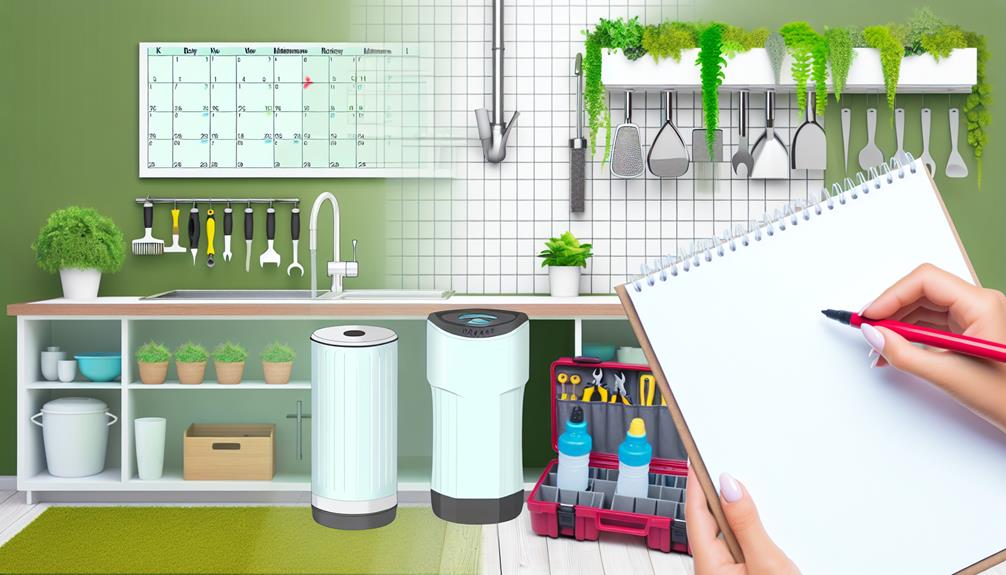
To ensure your home water filtration system operates at peak efficiency, you must adhere to a strict maintenance regimen. This involves:
- Prompt replacement of filters according to manufacturer specifications
- Thorough cleaning of system components
- Vigilant monitoring of system performance indicators
Neglecting these critical steps can result in subpar water quality and decreased system longevity.
Regular Filter Replacement
Have you ever considered how regular filter replacement is crucial for maintaining the optimal performance of your home water filtration system? To ensure efficacy, you must adhere to the manufacturer's recommended schedule. Modern systems often feature filter alarms to alert you when a change is imminent. Furthermore, subscription services exist to automate the replenishment process, thereby eliminating guesswork and ensuring timely replacements.
Consider the following points:
- Neglected filters become breeding grounds for bacteria and mold.
- Efficiency declines as filters clog, compromising water quality.
- Replacement intervals are designed to maintain peak system performance.
- Delayed filter changes can lead to costly repairs or system failure.
Adhering to a disciplined replacement schedule is paramount for the continued provision of clean, safe drinking water.
Cleaning System Components
Beyond replacing filters, regularly cleaning the components of your home water filtration system plays a critical role in sustaining its functionality and longevity. Filter sanitization removes contaminants that may hinder performance, while ensuring component compatibility preserves system integrity.
Here's an analytical breakdown of the process:
| Component | Maintenance Task | Frequency |
|---|---|---|
| Filter Housing | Sanitization | Biannual |
| O-rings | Lubrication/Replacement | Annual |
| Pipes & Fittings | Inspection/Cleaning | Biannual |
To maintain optimal operation, adhere to manufacturer-specific guidelines for each component. Utilize recommended cleaning agents and procedures to avoid damaging sensitive parts. Remember, systematic care not only guarantees the delivery of clean water but also prevents costly repairs down the line. Technical vigilance is paramount in the upkeep of your filtration system.
Monitoring System Performance
Regular monitoring of your home water filtration system's performance is essential to detect any decline in water quality or filtration efficiency. To ensure the system operates optimally, you must track performance metrics and respond to filter alerts promptly.
Consider the following:
- Filter Life Expectancy: Monitor the lifespan of filters to anticipate replacements before efficiency drops.
- Water Pressure: Low pressure can indicate cloggings or malfunctions.
- Turbidity: High levels suggest compromised filter integrity.
- Taste and Odor: Changes can signal the presence of contaminants.
Reacting to these indicators with prompt maintenance can prevent system failure and safeguard your household's water purity.
Contaminant Removal Capabilities
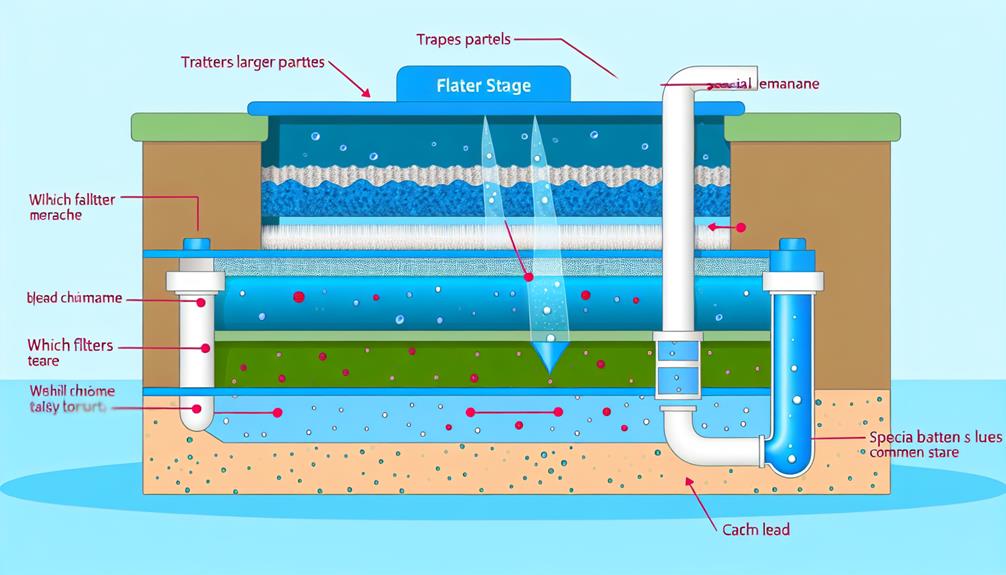
When selecting a home water filtration system, it's crucial to understand its efficacy in eliminating specific contaminants that may be present in your water supply. The health impact of consuming contaminated water can be significant, and filter certification offers assurance that a system meets established removal standards.
It's not just about taste and odor; you're looking to reduce or eliminate harmful substances such as lead, chlorine, pesticides, and pathogens that can adversely affect health.
To assess a system's contaminant removal capabilities, check for certifications from reputable organizations like the NSF (National Sanitation Foundation) or the WQA (Water Quality Association). These certifications mean the filter has been tested and proven to remove certain contaminants to a specified degree.
Remember, not all systems are equally effective against all types of contaminants. Some may excel at reducing heavy metals, while others are better at tackling organic compounds or microbial cysts.
Therefore, it's essential to analyze your water quality report or have your water tested to identify the specific contaminants you need to target. Once you know what you're dealing with, you can make an informed decision and select a filtration system optimized for those particular challenges, ensuring the safety and purity of your home's water supply.
Installation and Setup Guide
Having selected a water filtration system that meets your contaminant removal needs, it's crucial to focus on the proper installation and setup to ensure its optimal performance and efficiency. Analyzing the process with a technical lens, let's delve into the intricacies of the installation:
- Filter Placement: Determine the most strategic location for your system. It should be easily accessible for maintenance while minimizing the length of piping, which can affect water pressure and flow rate.
- Connection Integrity: Ensure all fittings are secure and leak-free. Utilize the appropriate sealants or plumber's tape to thwart any potential water damage or system malfunction.
- Pressure Regulation: Verify that the water pressure is within the recommended range for your specific filtration unit. Excessive pressure can cause damage, while too low a pressure may result in inadequate filtration.
- Troubleshooting Tips: Familiarize yourself with common issues that may arise post-installation. Keep the user manual handy for quick reference, and understand the indicators of filter replacement or system distress.
In your approach, be methodical, ensuring each step is carefully executed. Any oversight during installation can lead to subpar water quality or even system failure. Remember, a meticulous setup is the bedrock of long-term water purification success.
Cost-Benefit Analysis
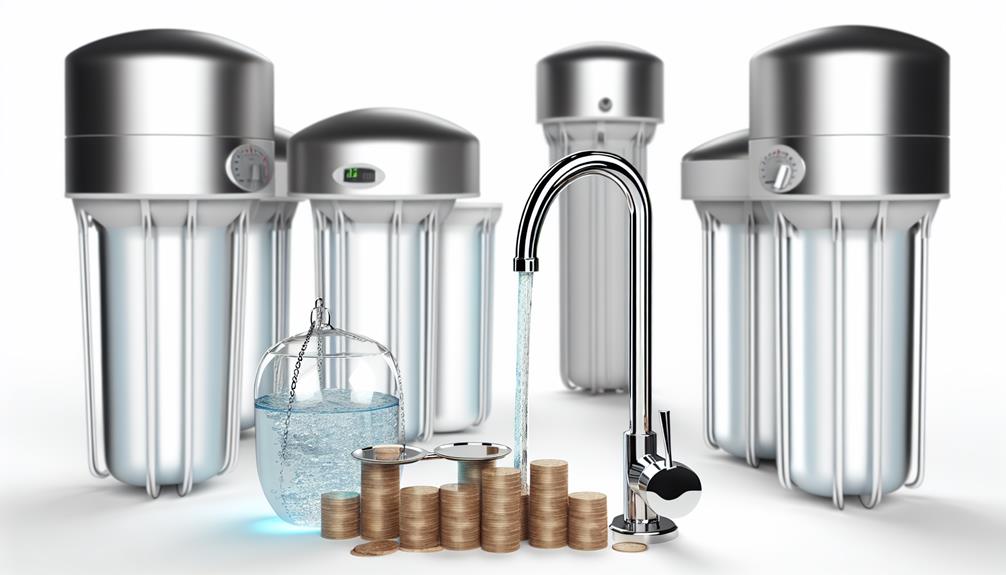
Assessing the cost-benefit ratio of your home water filtration system is essential to determine its long-term value and sustainability.
The initial investment in a high-quality water filtration system can be substantial; however, it's critical to project the ongoing savings against the upfront costs. You'll need to analyze the price of replacement filters, energy consumption for powered systems, and potential maintenance fees. These recurrent expenditures, when compared to the cost of bottled water or the healthcare expenses associated with contaminated tap water, can reveal significant long-term savings.
Moreover, it's imperative to consider the environmental impact of your choice. A robust home water filtration system can drastically reduce your reliance on plastic bottles, thereby minimizing your carbon footprint. The production and disposal of plastic contribute to environmental degradation, thus integrating an efficient water filtration system isn't only an investment in your health but also in the planet's welfare.
In your analysis, factor in the expected lifespan of the system and its components. Higher quality systems may come with a steeper initial investment but often offer greater durability and require fewer replacements over time. It's a balance of upfront costs versus ongoing benefits—both monetary and ecological—that will guide you to a prudent decision.
Brand and Model Reviews
Before making a final decision on your home water filtration system, it's crucial to scrutinize reviews of various brands and models to gauge their performance and reliability. Analyzing consumer feedback and expert opinions can reveal invaluable insights regarding the efficacy and durability of different systems.
When assessing reviews, consider the following:
- The longevity of filter warranties as an indicator of manufacturer confidence.
- The responsiveness and helpfulness of customer support in resolving issues.
- The frequency of maintenance or replacement needs, affecting long-term costs.
- User satisfaction rates, reflecting real-world performance beyond laboratory testing.
Filter warranties offer a safety net, ensuring that you're not left out of pocket should the system fail prematurely. Moreover, robust customer support can be the difference between a quick fix and a prolonged inconvenience, especially when dealing with complex installations or troubleshooting.
Conclusion
In concluding, you've got to weigh your water quality needs against the filtration options available. Whether you opt for a pitcher, faucet attachment, or a whole-house system, remember that reverse osmosis stands out for its contaminant removal prowess.
Carefully consider installation complexity and long-term costs. With comprehensive reviews, you'll find the brand that best fits your criteria.
Make an informed decision; your health and wallet will thank you for the diligence in selecting an optimal home water filtration system.
